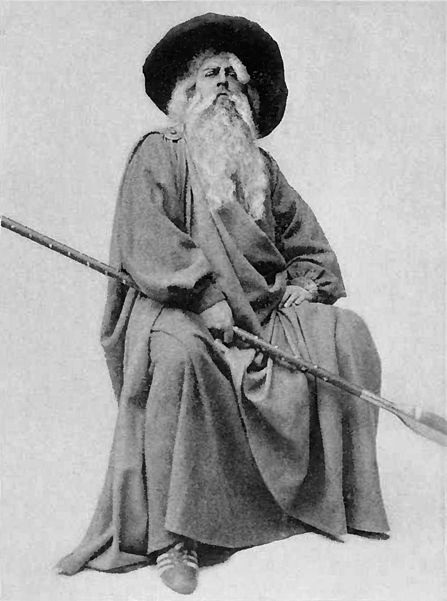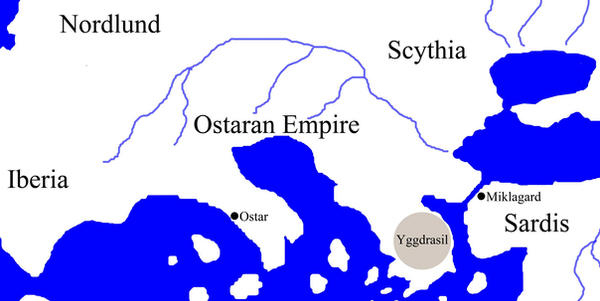
The Glasir Plains is a region in Midgard that stretches from Eastern Scythia all the way to the Herma river, the border of Risaland. It is a land of vast expanses of grass, bogs and steppe lands. It is here that the greatest collection of Trolde have formed their own savage kingdom.
Long ago, these Trolde were the thralls of the Giants of Risaland, but gained their independence and escaped to the Glasir Plains. There they have established a semi-nomadic way of living, tending herds of horses, and maintaining walled towns and cities of wood and sometimes stone. Though they are separate from Risaland, the Glasir Trolde still pay tribute to their ancient masters, though they resent this tithe greatly.
The other nations have a great deal of fear and respect for the Glasir Trolde, as they are a potent and deadly force. And though savage and occasionally hostile, they can be dealt with, and can make for profitable trading partners for those merchants with a stout heart and strong arm.
Not just trolde live amongst the tribes. A great many Human slaves and trollborn (see below), as well as a great many of the lesser sorts of Jotun. Such jotun are seen as noble kin by the Trolde, and are permitted their own holdings and tribal regions. The addition of Plains or Rock Jotun troops in a war host is greatly desired by most chieftains, as their long range attacks and great strength are invaluable against mounted foes, walled towns and cities.
Racial traits for the Trolde race can be found here.
Godmund (High Trolde King)
 “I am but an unknown king with an iron crown, trying to lift a race of savages out of the slime into which they have sunk.” -Bran Mac Morn, Robert E. Howard
“I am but an unknown king with an iron crown, trying to lift a race of savages out of the slime into which they have sunk.” -Bran Mac Morn, Robert E. HowardThe king over all of the Trolde Earls and Chieftains of the Glasir Plains. The king of the Glasir Trolde ascends to the throne, he is renamed Godmund, despite his original name. The position is hereditary, with the closest male relation taking the position upon the elders death. Much like the Emperor of the Ostaran Empire, a new Godmund must be voted in, however in this case the Godmund is voted in solely by the Hagmoot (see below).
Godmund is largely a war king, directing his Earls and Chieftains in battle, and is by necessity an extremely powerful and charismatic being. Politics amongst the Earls, Chieftains and Hags runs hot at court, needing a strong and cunning king to keep the tribes working together. This along with enemies at all sides keeps a Godmund quite busy.
The present Godmund is an old-fashioned Trolde, content to sit on his treasure and let his Earls and Chieftains do as they like, as long as tribute is paid. It is said that he is an enormous Trolde, with many daughters and a personal army of terible potency. His chief wife is reputed to be a Hag of tremendous power and guile.
Capitol: The Godmund resides in the great fortress city of Trolgard, far to the East. The city is surrounded by an enormous stone wall, constructed by Stone Giant masons and enhanced with elemental magic. All races are permitted to visit and trade here, but must obey the customs.
Delegates and traders from many lands may be found here. And as long as they observe the customs of Trolde society, they are permitted to stay. Priests of foreign gods are permitted to erect shrines and temples, but aggressive channelization is met with the full malice of the Hagmoot.
Hagmoot
 "The owl is abroad,the bat and the toad,
"The owl is abroad,the bat and the toad,And so is the cat-a mountain,
The ant and the mole sit both in a hole,
And frog peeps out o'the fountain;
The dogs they do bay,and the timbrels play,
The spindle is now a-turning;
The moon it is red,and the stars are fled,
And all the sky is a-burning."
-Witches Song, Ben Jonson
Trolde society is under the protection of a sisterhood of powerful witches (female trolde druids) who maintain a vast network amongst the tribes. This network is of Druids and specialized Adepts, who advise their chieftains and earls in nearly all matters. Druids in this network must be female, though Adepts may be male (and defer to female members in all matters). The hags are intent of the protection of the ancient traditions of the Glasir Trolde, and use all manner of resources to do so.
These witches specialize in divination and weather oriented magic, creating stone circles and earthen mounds to better track the heavens. Terrible rituals are enacted by the hags, often involving bloody sacrifice and communion with powerful spirits. A great many Cromlech (see Arcane Magic) dot the Glassir plains, and are well marked and watched by the hags.
Only the most foolish of Trolde disregards the advice of the Hagmoot. However many male trolde at least somewhat resent the meddling of the Hags in their affairs, and take what liberties that they can. Many trolde from the tribes fear females of strong personality, even amongst other races, as they are raised to fear "womens magic" and to respect a womans authority.
Life in The Tribes
 'For a couple o' pins,' says Troll, and grins,
'For a couple o' pins,' says Troll, and grins,'I'll eat thee too, and gnaw thy shins.
A bit o' fresh meat will go down sweet!
I'll try my teeth on thee now.
Hee now! See now!
I'm tired o' gnawing old bones and skins;
I've a mind to dine on thee now.'
-The Stone Troll, J.R.R. Tolkien
The Glasir Trolde are semi nomadic, traveling with their herds of horses, only staying in one place for long during the winter months. It is a chieftains duty to lead such migratory bands across the plains, establishing traditional pastureland for his peoples herds. Permanent settlements are maintained by Earls, which are largely stone or wood fortresses with storehouses for grain and other valuables.
Trolde nomads bed down under elaborate tents which are erected at great speed, and are of high quality. Trolde either go along on Horseback or in Wagons, though wagon riding is seen as a feminine practice. Trolde braves with the Run feat (particularly Barbarians) have been known to run rather than ride, showing off their great stamina.
Warrior Society: With the threat of Risaland to the East, the Frost Giants to the North, and a great many predators and other foes around, the Trolde need to be tough, and ready for battle.
All trolde non-spellcaster males are taught at least the rudiments of combat and will always have ranks in a battle ready class. This is most often the Warrior NPC class, with the elite having ranks in a PC class, favoring Barbarian and Fighter.
Social Rank: No Glasir Trolde has a social rank lower than a Freeman, as having been slaves in Risaland, they disdain forcing such a rank upon their own kind. This does not keep them from enslaving Humans however. Amongst the Trolde, their is only one King, called Godmund (see above) regardless of his real name.
Food: Trolde of all lands have enormous appetites, particularly for strong drink. The Glasir Trolde brew several potent alcoholic beverages, including a strong "wine" made from horses milk. Horse and goat flesh is eaten regularly as is the flesh of wild game (and fallen slaves and enemies). Ground grains are rarely consumed by nomad bands, as keeping this fare on the move is very difficult.
Trolde Horse Breeding: Trolde of the Glasir Plains are renowned for their skill in the breeding of horses. Trolde horses are always of the "Heavy" variety. Though most of these horses are kept as food animals, select breeds of war horse are bred for use for cavalry (Heavy War Horse). All trolde bred horses are desired by the other nations, with only geldings being available for sale to outsiders.
Religion: Trolde believe that they are born from the "flesh" of the land (from the flesh of Ymir), and so they see the very land as an object of worship and their parent. Trolde observe a great many rituals, mostly surrounding thanking and appeasing the land and weather for its gifts, and being watchful for its displeasure. Though female trolde handle the majority of Trolde religion, males can be found in the role of Jotun or even Vanir Cleric or Adepts in their veneration.
Trollborn (New Race)
Trollborn are the result of the mating of Trolde and Humans, often from human slaves, though love pairings do exist. Troll women are as likely to pursue such pairings as males, and far more likely to survive the birthing. Trollborn generally resemble big, ugly humans, though some are obviously of Trolde stock. Trolde with the scent feat always recognize a Trollborn for what it is. Though many trollborn have pot bellies and seem obese, all have strong arms and broad shoulders (even the women), and are much prized as warriors.
Within Trolde society, Trollborn are seen as sickly and small, but not without their uses. None may advance beyond the status of a Freeman, but are never considered Thralls. hey are used as scouts, hunters and assorted specialist regularly. In Human society, Trollborn are despised as monsters and suspected of all manner of evil. Still, this evil reputation can be desireable in some circles, and thus they can be found leading bands of outlaws and similar scum.
Traits:
- +2 Strength, -2 Dexterity, -2 Charisma
- Size: Medium.
- Base Speed: 30 feet.
- Darkvision: Trollborn can see in the dark up to 60 feet. Darkvision is black and white only, but it is otherwise like normal sight, and trollborn can function just fine with no light at all.
- Giant Blood: For all special abilities and effects, a trollborn is considered a giant.
- Automatic Languages: Common and Trolsprog.
- Bonus Languages: Dwarven, Giant, Hyborean, Terran and Abyssal.
- Favored Class: Barbarian (Male) or Druid (Female).































